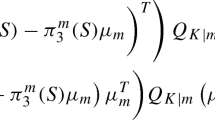Summary
This paper compares different approaches to the multivariate analysis of interval data, focusing on discriminant analysis. Three fundamental approaches are considered. The first approach assumes an uniform distribution in each observed interval, derives the corresponding measures of dispersion and association, and appropriately defines linear combinations of interval variables that maximize the usual discriminant criterion. The second approach expands the original data set into the set of all interval description vertices, and proceeds with a classical analysis of the expanded set. Finally, a third approach replaces each interval by a midpoint and range representation. Resulting representations, using intervals or single points, are discussed and distance based allocation rules are proposed. The three approaches are illustrated on a real data set.



Similar content being viewed by others
References
Beheshti, M., Berrached, A., de Korvin, A., Hu C. & Sirisaengtaksin, O. (1998), On Interval Weighted Freelayer Neural Networks in ‘Proc. of the 31st Annual Simulation Symposium’ IEEE Computer Society Press, pp. 188–194.
Bertrand, P. & Goupil, F. (2000), Descriptive Statistics for Symbolic Data in ‘Analysis of Symbolic Data, Exploratory methods for extracting statistical information from complex data’, Bock, H. H. and Diday, E. Eds., Springer, Heidelberg, pp. 106–124.
Billard, L. & Diday, E. (2003), ‘From the Statistics of Data to the Statistics of Knowledge: Symbolic Data Analysis’, Journal of the American Statistical Association 98 (462), 470–487.
Bock, H. H. & Diday, E. (2000), ‘Analysis of Symbolic Data, Exploratory methods for extracting statistical information from complex data’, Springer, Heidelberg.
Case, J. (1999) ‘Interval Arithmetic and Analysis’, The College Mathematics Journal 30 (2), 106–111.
Chouakria, A., Cazes, P. & Diday, E. (2000), Symbolic Principal Component Analysis in ‘Analysis of Symbolic Data, Exploratory methods for extracting statistical information from complex data’. Bock, H. H. and Diday, E. Eds., Springer, Heidelberg, pp. 200–212.
Do T.-N. & Poulet, F. (2005), Kernel Methods and Visualisation for Interval Data Mining in ‘Proc. of the Conf. on Applied Stochastic Models and Data Analysis, ASMDA 2005’. Janssen, J. and Lenca, P. Eds., ENST Bretagne, Brest, pp. 345–354.
Gnanadesikan, R. et al.-Panel on Discriminant Analysis, Classification and Clustering (1989), ‘Discriminant Analysis and Clustering’, Statistical Science 4 (1), 34–69.
Hand, D. J. (2004), Academic Obsessions and Classification Realities: Ignoring Practicalities in Supervised Classification in ‘Classification, Clustering and Data Mining Applications’. Banks, D. et al Eds., Springer, Berlin, Heidelberg, New York, pp.309–332.
Lauro, C. & Palumbo, F. (2005), Principal Component Analysis for Non-Precise Data in ‘New Developments in Classification and Data Analysis’. Vichi, M. et al Eds., Springer, pp. 173–184.
Lauro, C., Verde, R. & Palumbo, F. (2000) Factorial Discriminant Analysis on Symbolic Objects in ‘Analysis of Symbolic Data, Exploratory methods for extracting statistical information from complex data’. Bock, H. H. and Diday, E. Eds., Springer, Heidelberg, pp. 212–233.
Moore, R. E. (1966), ‘Interval Analysis’, Prentice Hall, New Jersey.
Neto, E. A. L., De Carvalho, F. & Tenório, C. (2004), Univariate and Multivariate Linear Regression Methods to Predict Interval-Valued Features in ‘AI2004: Advances in Artificial Intelligence, Proc. of the 17th Australian Conf. on Artificial Intelligence’, Lecture Notes on Artificial Intelligence, Springer Verlag, pp. 526–537.
Rossi, F. & Conan Guez, B. (2002), Multilayer Perceptron on Interval Data in ‘Classification, Clustering and Data Analysis’, Jajuga, K., Sokolowski, A., & Bock, H. H. Eds, Springer, Berlin, Heidelberg, New York, pp. 427–434.
Síma, J. (1995), ‘Neural Expert Systems’, Neural Networks 8 (2), 261–271.
Simoff, S. J. (1996), Handling Uncertainty in Neural Networks: an Interval Approach in ‘Proc. of the IEEE International Conference on Neural Networks’. IEEE, Washington D. C., pp. 606–610.
Acknowledgements
Both authors were supported by FCT/MCTES (Programa Operational Ciência e Inovação 2010). The second author was further supported by Calouste Gulbenkian Foundation.
Author information
Authors and Affiliations
Rights and permissions
About this article
Cite this article
Silva, A.P.D., Brito, P. Linear discriminant analysis for interval data. Computational Statistics 21, 289–308 (2006). https://doi.org/10.1007/s00180-006-0264-9
Published:
Issue Date:
DOI: https://doi.org/10.1007/s00180-006-0264-9




